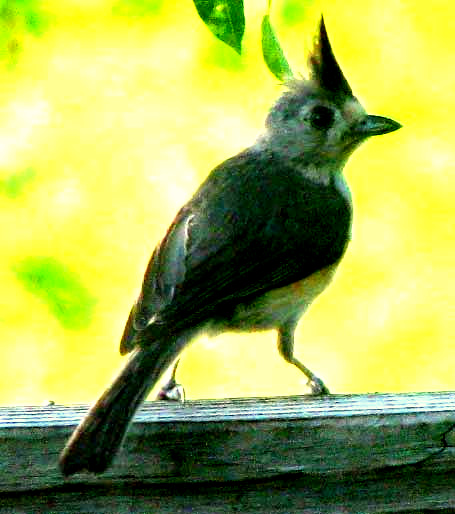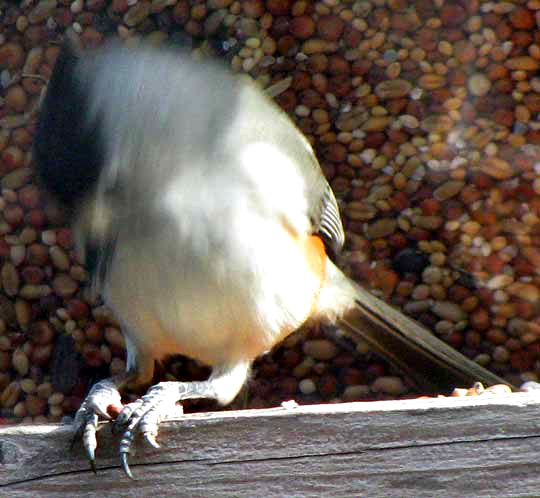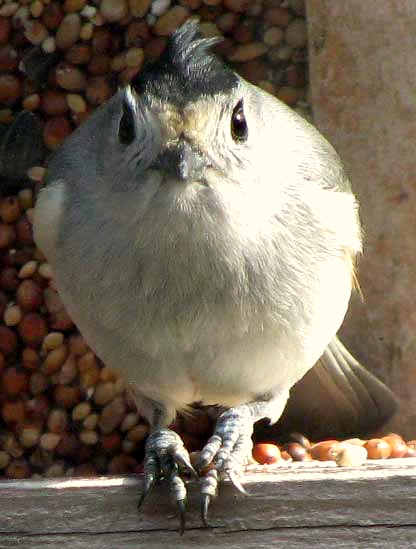Excerpts from Jim Conrad's
Naturalist Newsletter
from the July 7, 2013 Newsletter issued from the Frio Canyon Nature Education Center in the valley of the Dry Frio River in northern Uvalde County, southwestern Texas, on the southern border of the Edwards Plateau; elevation ~1750m (~5750 ft); N29.62°, W99.86°; USA
BLACK-CRESTED TITMICE
Tufted Titmice are among the most common and best known of songbirds in the eastern US and southernmost Canada, but from what I've seen so far we don't have them here. We do have plenty of titmice, but they're Black-crested Titmice, BAEOLOPHUS ATRICRISTATUS, such as the one shown below:

Our Black-crested ones look like, sound similar to and behave like Tufted Titmice -- other than that their tufts are black, not gray. You can compare the above picture with that of a Tufted Titmouse back in Mississippi at http://www.backyardnature.net/n/b/tuft-tit.htm.
Also, notice that the forehead -- the area immediately above the beak -- on our bird is white, while Tufted Titmice foreheads are black. However, the crests of immature Black-crested Titmice are not black, as shown below by one about to scratch with his beak beneath his raised wing:

My dog-eared 1966 field guide recognizes Black-crested and Tufted Titmice as different species, but during much of my birding career the two have been lumped, with our black-crested birds being considered a mere variation of the Tufted Titmouse. However, as of 2002 most authorities have begun separating the two species again. The USGS, whose distribution maps pop up when you do a search on bird species, continues to lump the two populations on the basis of hybridization occurring in central Texas and southwestern Oklahoma.
Michael Overton's "Birds of Uvalde County, Texas" checklist shows Black-tufted Titmice as abundant here throughout the year, but Tufted Titmice are not listed at all.
Our Black-crested Titmice seem to me a bit less trusting than the East's Tufted Titmice. Black-cresteds are less likely to flit close when squeaking or pishing sounds are made to attract them. At the birdfeeder, unlike House Finches and Chipping Sparrows who stay and gorge, our Black-crested Titmice flit onto the feeder, snatch a seed and immediately fly to the nearby woods to eat it.
from the January 5, 2014 Newsletter issued from the Frio Canyon Nature Education Center in the valley of the Dry Frio River in northern Uvalde County, southwestern Texas, on the southern border of the Edwards Plateau; elevation ~1750m (~5750 ft); N29.62°, W99.86°; USA
TITMOUSE HOLD-HAMMERING

Above a Black-crested Titmouse has just flitted onto our feeder, grabbed a seed, positioned it between his feet, and now is pounding it with his beak. This feeding technique, called hold-hammering, occurs throughout the Titmouse/Chickadee Family, the Paridae. Since most other kinds of birds don't hold-hammer, a good guess is that the behavior is genetically based, and that the ancestor to all species of the Paridae passed along the gene or genes predisposing the hold-hammering technique to its descendents. We've seen the Carolina Chickadee, also a member of the Paridae, hold-hammering, shown at http://www.backyardnature.net/n/12/120422c2.jpg.
In the chickadee picture it's curious that the bird seems to be pounding the seed with his beak open. A picture of this week's titmouse with his head motion-blurred on the downswing, also with his beak open, is shown below:

If you want to see the funny look on a hardworking titmouse's face when he's staring straight at you, head-on, that's him below:
